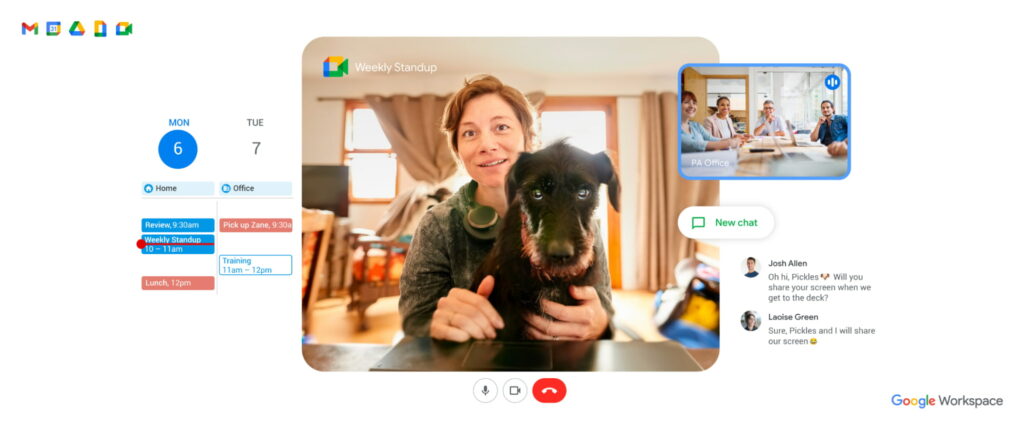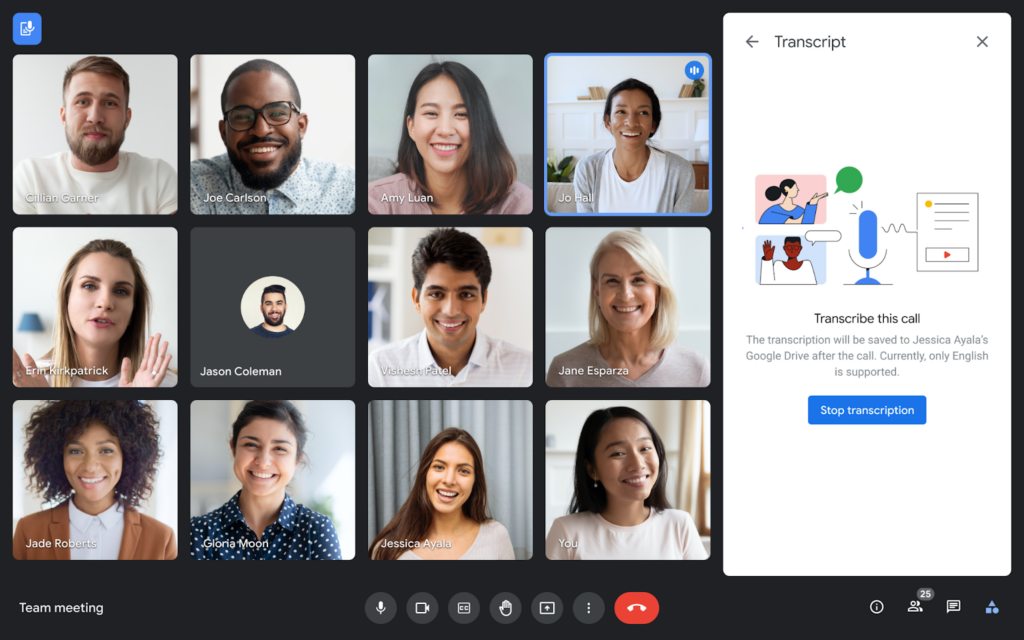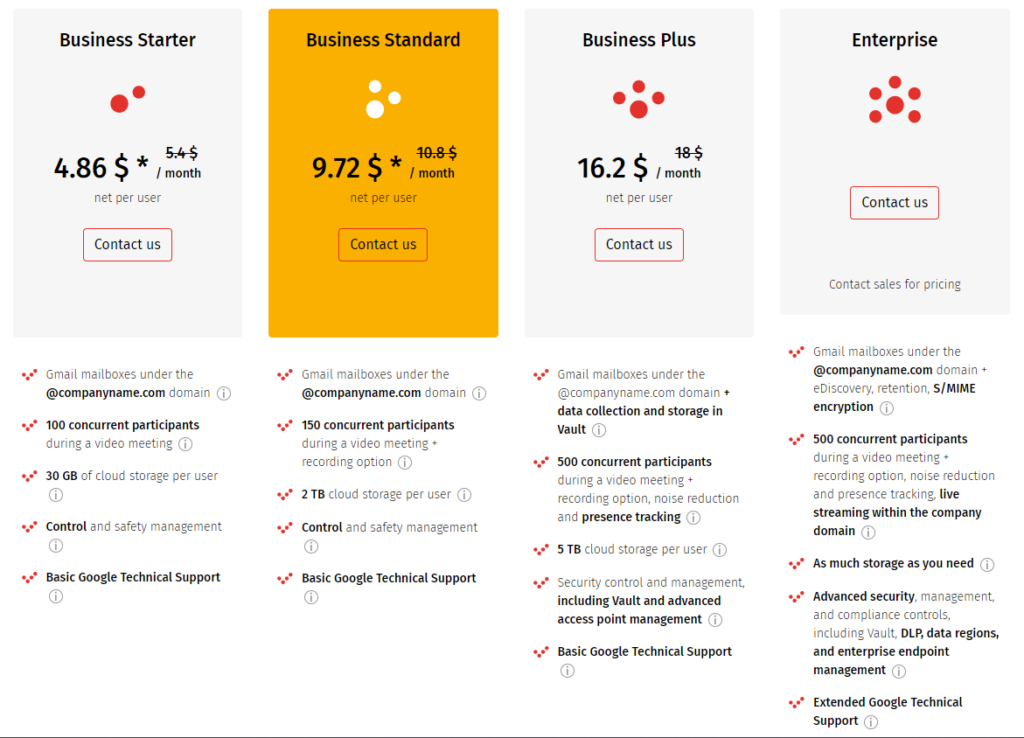Video conferencing tools gained a lot of traction in the last few years, becoming crucial for businesses nowadays. With most companies needing to go remote overnight, Google Meet and Zoom quickly became two of the most popular platforms to organise online meetings and keep business as usual even from afar.
Do you find yourself in the position of choosing an interface that best accommodates your business needs? The following head-to-head Google Meet vs. Zoom comparison will help you understand their similarities and differences. This way, you can decide which tool will be the best fit for your organisation.
An overview of Google Meet vs. Zoom
Meet and Zoom are nowadays synonymous with video calls, especially in corporate settings.
Both platforms offer a range of features to support virtual meetings and collaboration. At the same time, they differ in a few key areas.
Here’s a quick overview of a Google Meet vs a Zoom account.

Meet vs Zoom – group meetings titans
Zoom and Google dominating the market is not a phenomenon that arose out of nowhere. Both of these apps have been deeply ingrained in corporate culture for years. Zoom is one of the first tools to host online audiovisual conversations, with its launch in 2011.
Meet’s genealogy, on the other hand, is much more complicated. Google has a history of frequently replacing its apps with brand new ones. All along, these Google apps keep on changing and rebranding. In its current form, the Google Meet app was launched in 2017, but its predecessor, Google Hangouts, has been running for many years ahead of it.
No one could have expected that online meetings could become such an important way to communicate for organisations around the world. Google CEO Sundar Pichai announced in 2020 a whopping 100 million daily active Meet users, right in the midst of work from home and at home classes. A couple of years down the line, Google Meet, Zoom, and Microsoft Teams even solidified their positions as convenient video conferencing tools for businesses and much more.

Meet vs. Zoom Meetings – Similarities
For online virtual meetings to be successful, video conferencing tools need to have certain features. If you need to find the right fit for your business, you might find it hard at first to tell the difference between Google Meet calls and Zoom meetings.
Free plans for Google Meet and Zoom
Both applications offer limited possibilities of using the service for individual users with free accounts. They will allow you to have up to 100 participants in one video meeting, with calls extending to 40 minutes on Zoom and 60 minutes on Meet.
These free plans will still allow users to have in-meeting chat, whiteboard or Jamboard, co-annotation, waiting room or secure two factor authentication.
Availability on multiple platforms
Both Google Meet and Zoom can be used without any problems on desktop computers with Windows and Mac systems and on mobile devices based on Android or iOS.

Recording video conferences
Video calls from both of these tools can be recorded and saved if all users agree to it. For businesses, the Google Workspace editions allow you to record meetings if you are either the host, promoted as a co-host, are representing the organisation or you a teacher for meetings created through Google Classroom.

You can extend your reading on the matter with the following article:
Screen Sharing
Each video conference attendee can share its screen to better illustrate their speech. Using this feature, people can better show the practical part of the project, involve colleagues in discussing the contents of the file, or simply display a slideshow prepared for the occasion.
With Google Meet, you can directly share your working Google Docs, Sheets or Google Slides. This way, your team can give you feedback in real time.
Google Meet and Zoom: Messages and group chat
We’ve all been in a situation where, during a phone call, being able to send a text or a link would have been useful. When making video calls via Zoom or Meet, the option to send any content in the correspondent group chat is also available.
Encryption
Although the level of security for both Google Meet and Zoom meetings app is not identical, both platforms ensure that the content of your conversations is encrypted.
Subtitles and transcripts
As said before, both apps offer the ability to record meetings – while also transcribing them. You can turn on live captions in Google Meet and export them at the same time with the recorded meeting. The transcribed file will be saved in the hosts ”Meet Recordings” folder in Google Drive, similar to meeting recordings.
This feature can only be accessed when using Google Meet on a desktop or laptop. You can transcribe meetings only if you have a Google Workspace subscription. It is not available for any free plan or free version of the app.

Meet and Zoom – attendees limitations
Being two of the most popular video conferencing tools, Zoom and Google Meet have extensive limits. Let’s compare some video conferencing features:
Zoom is limiting the attendees as follows:
- Up to 100 people in a Zoom meeting for the cheapest subscriptions, dedicated to small teams (max. 9 licences, same for the free Zoom users)
- Up to 300 participants in the chat room for small businesses with max. 99 licences
- Up to 500 participants in the most extensive and expensive Zoom subscription, with paid add-ons that can get the meeting to max. 1.000 attendees
For Google Meet, you get unlimited meetings as follows:
- Up to 100 people meeting capacity in the Google Workspace Business Starter edition;
- Up to 150 people in the Google Workspace Business Standard edition;
- Up to 500 people in Google Workspace Business Plus and Google Workspace Enterprise; additionally, Enterprise customers can live stream Google Meet calls for up to 10.000 people within the company domain.
Zoom allows you to expand the participant limits to 1,000 people with the Zoom Large Meeting extension from 50 USD per month. There are no additional charges for Google Meet.
Google Meet, part of coherent ecosystem of productivity apps
One of the most important differences between the two is that Meet is part of a coherent ecosystem of cloud office programs, while Zoom is a stand alone app. Both tools integrate perfectly with other popular business software. However, by purchasing Meet, previously known as Google Hangouts, as part of the Google Workspace, your company also benefits from:
- Business Gmail accounts with your own domain;
- Google Chat to sustain one on one meetings in written;
- Google Calendar and all the file editor software;
- Management and administrative console with a Google Workspace toolbar;
- Many other Google apps and services necessary for office work.

When acquisitioning Zoom licences for your employees, you need to cover the same basic functions of the former Google Suite platform with other tools from other manufacturers. By working with many different subscriptions from different providers, you will make it harder to optimise the costs of everyday work for your company.
Google Meet, a cloud optimised app available in browser
Like all productivity Google services, Google Meet was built for hosting video calls via browser. On the other hand, Zoom was developed as a local application installed on the hard drive. The ability to run Zoom meetings in browsers was launched relatively recently.
The possibility to create and join meetings is just a click away with Google Meet – either from Calendar, Gmail or the Meet url. Starting a Zoom video call however involves additional steps, such as entering a meeting ID or setting a user’s display name.

Read also:
How does security compare for Google Meet and Zoom?
Another major discrepancy between these two video conferencing tools is the level of security and administrative control.
Google Meet is known for its robust security features, including end to end encryption, two-step verification, and the ability to monitor and control who joins your meetings or breakout rooms. Zoom, on the other hand, has faced criticism in the past for security vulnerabilities like the phenomenon of Zoombombing. However, the company has since taken steps to improve its security and privacy features, including adding end-to-end encryption, waiting rooms, and password protection for meetings.
Google Meet’s privacy settings are tightened by default, and conference links are much harder to remember or guess. In most cases, the host does not need to take any additional steps to avoid uninvited guests to these remote meetings.
You can read some more on the topic of security:
Only people from within the domain with a special link can enter a Meet room. If someone wants to join the call using an unknown account, the host must agree to it.
Even if someone who has already been admitted to the Meet room starts behaving suspiciously or disrupts the conversation, the organiser can mute or even permanently remove the individual from the call.

Google Meet vs. Zoom – A price comparison
While the free version apps of Meet and Zoom are very similar, their paid plans differ significantly.
How much does Google Meet cost?
Meet is just one of the many components of this productivity suite called Google Workspace. By purchasing a Google Workspace license, in addition to the video conferencing tool, you also get mailboxes with our own domain, file editor apps and dozens of administrative options. The least extensive Business Starter package can be purchased for 4.86 EUR per user per month. The Business Standard package costs 9.72 USD per user, while the most advanced edition meant for companies with up to 300 employees is priced at 16.20 USD per user per month. You can find full pricing for all the Google Workspace plans and more details on this page.

How much does Zoom cost?
The cheapest edition of Zoom costs 13.99 USD per user per month, while the Business and Enterprise packages cost around 20 USD. One can extend the Zoom subscription with additional paid options and functions like the large meetings add on, which significantly reduces the transparency of the price list.
Overall, there is a difference of over 9 USD between the cheapest Meet and Zoom editions. In the midst of a protracted post-pandemic and economic crisis, with many companies looking for ways to painlessly cut costs, it’s hard to ignore such a price gap.
Our recommendation – choose Google Meet with the help of a Google partner
Affordable prices and the guarantee of Google security are the two strongest aces in Google’s sleeve, which Zoom, unfortunately, cannot fully boast of. There are other features that we believe give Meet a significant competitive advantage:
No need to install local programs for face to face communication
Google Meet is just a web application, which means that you can take full advantage of its capabilities using your own web browser.With unlimited cloud storage for your meeting recordings, Meet becomes a very reliable option. One downside of Zoom is the requirement to install the program on the users’ hard drive.
Why can installing local apps be a dangerous endeavour? It’s more than the fact that they take up unnecessary storage on your device. One main problem consists of the many Zoom installation executables that are infected with malware or adware. Due to this, the average Zoom user can easily fall victim to cybercrimes.
Our recommendation – choose Google Meet with the help of a Google partner
Affordable prices and the guarantee of Google security are the two strongest aces in Google’s sleeve, which Zoom, unfortunately, cannot fully boast of. There are four more things that we believe give Meet a significant competitive advantage:
No need to install local programs for face to face communication
Google Meet is just a web application, which means that you can take full advantage of its capabilities using your own web browser.With unlimited cloud storage for your meeting recordings, Meet becomes a very reliable option. One downside of Zoom is the requirement to install the program on the users’ hard drive.
Why can installing local apps be a dangerous endeavour? It’s more than the fact that they take up unnecessary storage on your device. One main problem consists of the many Zoom installation executables that are infected with malware or adware. Due to this, the average Zoom user can easily fall victim to cybercrimes.
Same interface on all devices, for both web and mobile users
Google Meet works the same way, both in browser and on mobile devices. Thanks to this functionality, users are not exposed to frustration or uncertainty when, for some reason, they urgently need to join a meeting via the smartphone app. They will seamlessly know how to use the same basic functions on both versions of Google Meet.
It’s free to join a Google Meet via a phone call
In each of the Meet editions, the user has the option to join an ongoing conversation using just the regular telephone network. A unique phone number is generated automatically when someone is creating a meeting. This feature makes Google Meet highly available for everyone, making it easy to collaborate remotely when one of the guests has an Internet connection problem.
For Zoom, you have to pay extra for just a voice conference.At the same time, this service also guarantees more options for managing calls over the phone.
Much more than just Google Meet within Google Workspace
Meet is not only cheaper within the Workspace subscription, but its features expand to so much more than just the ability to make online video calls. When you buy a Google Workspace licence, you get access to the business version of Gmail and all its related applications.
Do you want to test Google Meet within the ecosystem for free? As an official Google partner, we can offer you a 30 days test period – twice as long as Google – with English support and training. Schedule right now a call with our cloud specialists.
